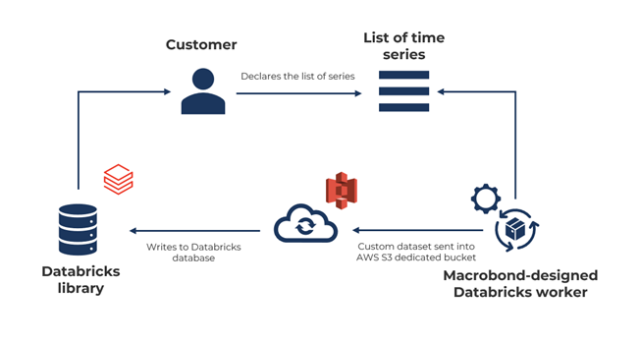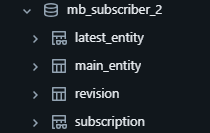- Introduction
- Data Discovery
- Set up your data feed in the Macrobond management panel
- Use your Snowflake data feed
Introduction
You can access any of Macrobond’s time series data into your Databricks environment. The data feed is intended for production purposes with near real-time updates.
Here’s how it works:

Data discovery
The Databricks data feed is used for production purposes only. Macrobond delivers the time series chosen by the consumer into their Databricks environment. There are various options to explore the Macrobond database and find the time series to be delivered into Databricks:
- Using Macrobond.net data catalogue. The Macrobond.net is a read only web portal that offers access to the tree structure and time series associated with every source included in the Macrobond base package.. Users can use it to explore the coverage and start documenting the primnames (unique identifiers) of the time series they would like to consume via Databricks.
- Using the Macrobond application. If you already subscribe to Core or Data+, the principles are the same as 1. above. If you subscribe to the desktop application, you have access to many more features including the analytics and sharing capabilities. Documenting a universe of time series via the Macrobond application can also be easier as it allows you to download the data in Excel or via API (Data+).
- Using the Macrobond Data Web API. Should you need to evaluate programmatically the time series data points, the Data Web API can also be used as a data feed product instead of being only an enabler to using the Databricks data feed.
- Using Macrobond’s data team. You can express various parameters that fit into your requirements so that Macrobond’s data team can generate a list of time series by converting these parameters into Macrobond-defined metadata fields. This allows you to evaluate the full database at scale. To ensure you access your definite universe, our team will discuss with you your exact requirements.
Set up your data feed in the Macrobond management portal
Once you know which time series you would like to receive in Databricks, or with the initial data set you are interested in, you can request the primnames through a dedicated portal provided by Macrobond.
The Macrobond team will provide access to this URL: https://feed.macrobond.com/login and send via email your Username and Password.
Here is an overview of the key features:
![]()
- Monitor your data feed properties

Your contractual allowance appears under “Unique Time Series limit”. You can use your feed during your subscription term (annual basis). You have an allowance of how many time series you can add or remove from your feed via the “Changes Per Month” counter, which corresponds to 10% of your total allowance. - Access your existing Subscription List and visualize or download the list of primnames you are subscribed to, including a flag denoting whether the series are feedable or not to be delivered via the feed (compliance module).
- Add time series to your data feed. You can add the primnames with a line break or decide to upload a list from a .csv file.
- Remove time series from your data feed.
Use your Databricks data feed
Once the time series are added into the Macrobond data feed management portal, the series are immediately delivered into your Databricks environment. Note that depending on the volume of time series, this operation can take some time to load.
Time series updates are also provided into Databricks with minimal latency as they are automatically pushed by Macrobond as soon as an entity received a complete update transaction in the backend.
The Pay-As-You-Go Data feed in Databricks provides access to a few tables and views. A data dictionary and sample notebook are available on the Databricks listing.
Here is an overview of the schema. Columns that are repeated across multiple tables or views will be skipped once described in a table definition.

MAIN_ENTITY [Table]
It delivers the full dataset but should not be used by users because it is redundant with the following tables or views. Instead, you should use either LATEST_ENTITY [View], derived from the MAIN_ENTITY table to obtain the latest version of your time series, or REVISION [Table] to obtain the vintages.
- PRIMNAME: unique identifier provided by Macrobond to identify a time series.
- METADATA: nest list of metadata fields for each time series containing lists or dictionaries.
- DATES: list of observation periods for the time series. Note that Macrobond uses the beginning of a period to denote the reference date. For instance, 2024-04-01 means “Q2 2024” in the case of a quarterly time series.
- OBSERVATION_VALUES: list of data points for the time series.
- ULID: a column intended to be used to join to REVISION (in conjunction with a PRIMNAME). This is a unique identifier for simultaneously transmitted time series (belonging to the same batch when loaded into Databricks). A newer batch of uploads always increments this value. In a given batch of uploads, a given time series can appear only once.
- NUMBER_OF_REVISIONS: number of unique vintages for the selected time series. The underlying data can be consumed in the REVISION table.
- LAST_UPDATE: time stamp when the time series was fully delivered and accessible in Databricks
- FEED_QUEUE_INSERT_TIMESTAMP: time stamp when Macrobond-designed Databricks worker added the time series to the insert queue as part of a loading batch.
REVISION [Table]
Some columns are already described in the previous table definition. New columns are:
- VINTAGETIMESTAMP: time stamp as to when this version of the time series containing data that could have been revision afterward it was made available in Macrobond.
Note that some time series have received a backfill to extend the point-in-time history directly from the source. As such, most of the time stamps prior to 2018 are arbitrary (as opposed to the date stamps).
To understand whether a time series received a backfill or not, you can refer to the time series metadata and look for fields: “RevisionHistorySource” and “RevisionHistorySourceCutOffDate”. When both fields exist, the time series was backfilled. The spread between the cut off date and the “FirstRevisionTimeStamp” provides the magnitude of the backfill. Revisions post cut off date are all captured and stored by Macrobond, not by the source.
When VINTAGETIMESTAMP = null, it corresponds to the first unrevised version of a time series as Macrobond knows it. We do not know at which point in time this version was published, until there is a first revision, captured by the subsequent VINTAGETIMESTAMP = FirstRevisionTimeStamp in the metadata from when the information is known.
In summary, every time series capturing Revision History in Macrobond starts with a first vintage time stamps = null.
- VINTAGEDATES: observation dates available as of the vintage time stamp.
- VINTAGEVALUES: observation points available as of the vintage time stamp.
SUBSCRIPTION [View]
You see the same information as you do in your data feed management portal. This is explained in 2. above. The table is updated once a day.
- PRIMNAME: requested primname. It can be an alias code.
- ACTUAL_CODE: primname in the Macrobond database.
- STATE: denotes the entity state. 0: active | 4: discontinued | -1: deleted
- AVAILABLE_FOR_FEED: 1: compliant | 0: non feedable. In case of non feedable time series, you can prove to Macrobond you have permission or a data license with the source and Macrobond can create a feedability exception on your account.
- LAST_UPDATE_IN_DATABRICKS: upload time stamp in Databricks.
LATEST_ENTITY [View]
Derived from the MAIN_ENTITY table, this view provides the latest version of your time series. It is the equivalent to the latest vintage available for time series storing Revision History.